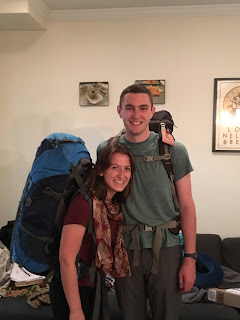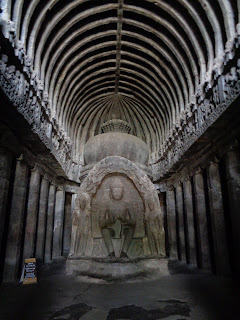IIT, Elephanta Caves, Dharavi Slum
Despite my exhaustion on Tuesday night, I was not yet able
to beat my jetlag. I went to sleep at 10:45; when I woke up, I was tired but
felt wide awake. I checked the time and it was 12:13am…I had expected to see 5:00
or 6:00am on my watch. Instead of making a futile attempt to go back to sleep,
I followed the advice of a co-worker at Apple: in his words, “when I travel, I
usually wake up at 2 or 3am and just start working.” I got up and worked for a
couple hours then eventually made it back to sleep around 3:30. For those readers
who have not skipped to the next paragraph yet, I am happy to inform you that I
slept well on Wednesday night.
Tuesday morning we visited IIT-Bombay, one of the most
prestigious schools in India. Entrance to the university is incredibly
competitive and is based on an applicant’s performance on a single exam. We
heard a lecture from Professor Sohoni, head of C-TARA, the Center for Rural
Technologies. He spoke about the role of C-TARA in helping people in villages
use the method of science to better their own communities. The “method of
science” is not just measurements and data analysis, but also incorporates
economics and social science perspectives. He also talked about how the Big
System (corporations) is not good for the world in terms of its contribution to
climate change; when facing the problem of climate change, everyone needs to be
informed on a global level but all actions must come from a local level for
them to be effective.
After the lecture from Professor Sohoni, we got a chance to
interact for a few minutes with some of Professor Subimol Ghosh’s students.
Professor Ghosh has worked closely with Professor Ganguly (Northeastern
professor) and Udit (Northeastern grad student TA). I talked with one student
named Shashi for a long time about climate, agriculture, and salaries. After
discussing more serious topics for a while, we chatted about how much different
professions make in the US and India.
We had a late lunch after our visit to IIT, followed by an
academic session. Most students, including me, did not venture out for dinner
because we were tired from the long day.
On Thursday (5/19), we visited the Elephanta Caves and the
Dharavi slum. The Elephanta Caves are a temple located on an island near the
city of Mumbai. They were chiseled out of the stone in the 6th
century. It took approximately 200 years for the caves to be completed. The
most amazing aspect of these caves is that it took over 5 generations for their
completion—there were no drawings or written instructions on how to proceed in
the chiseling of the rock. All features of the cave had to be passed down
orally from one master builder to the next. We will never know how much the final
state of the cave differs from its original design. After working two different
engineering jobs that were heavily focused on technical drawings, I cannot imagine
working on a project without at least a crude drawing of what the final product
would look like. Another interesting note about the cave: the columns are all
decorative and do not serve a structural purpose.
Other highlights of the trip out to the Elephanta Caves include
most of the group getting left behind on the dock and some great snacks on the
island. The docking area had rough water, so after 4 of us got on the boat, we
pulled away and were on the water by ourselves for about 15 minutes before the
rest of the group finally joined us. On the island I ate some delicious roasted
corn rubbed with lime and chili salt. I was constantly followed by a cow who
wanted my corn; I fed her the cob when I finished. Another great snack was unripe
mango slices with chili salt.
One final picture from Boston:
Rose (fellow TA) and I before leaving for the airport














Comments
Post a Comment